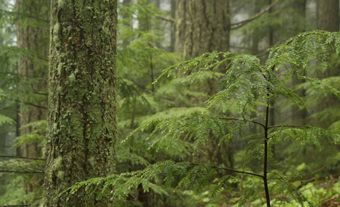The blue box is a plastic bin used in curbside recycling programs. The bins are filled with materials — including paper, glass, cans and select plastics — which are then collected by waste management professionals. Resource Integration Systems, the sister organization of a countercultural non-profit, and Superior Sanitation pioneered the blue box system in Kitchener, Ontario, in 1981. By 1986, the program began to operate province-wide. Today, blue boxes continue to be used in Ontario, home to one of the world’s most comprehensive recycling programs. Blue boxes are also used in municipal recycling programs in British Columbia, Alberta, Saskatchewan, Manitoba and Quebec.

Recycling and the Environmental Movement
Interest in recycling emerged among Canadians in the early 1970s. As part of the environmental movement, people saw recycling as a way to reduce landfill while also conserving natural resources. It was during this period that Pollution Probe, a Toronto-based environmental organization, coined the “3Rs” waste hierarchy: Reduce, Reuse, Recycle.
Despite the growing interest in recycling, there were few programs for the public to participate in. For example, the City of Toronto began experimenting with curbside newspaper pickups in 1971. However, those wanting to recycle other items, such as metal, plastic or non-newsprint forms of paper, had to seek out drop-off depots. Depots tended to be staffed by volunteers and were often short-lived operations. They were at the mercy of fluctuating market prices for reclaimed materials and the ability to secure government grants to cover operating costs.

Is Five Foundation
Central to the creation of the blue box was the Is Five Foundation (IFF). Launched in 1974 according to countercultural ideals, the IFF was a non-profit, registered charity. It ran as a collective, with the initial seven members all participating in decision making. The IFF engaged in a wide variety of activities. However, its greatest contributions were in the field of recycling. Here, the group’s experimentation resulted in significant advances.
In January 1975, the IFF launched its first initiative in Toronto’s Beaches neighbourhood. Called Project One Recycling, the initiative was the first roadside, multi-material pickup in Canada. It operated without specialized equipment. Participants left their recyclables on the curb in cardboard boxes or other containers, and organizers collected them using co-founder Jack McGinnis’s pickup truck. By 1977, an estimated 4,000 residents were participating in this program.
Did you know?
Jack McGinnis was a founder of the Is Five Foundation, Resource Integration Systems and the Recycling Council of Ontario. Due to his pioneering work he became known as “the father of the blue box.” He went on to develop recycling systems for events, including the 1992 Super Bowl in Minneapolis and Earth Summit in Rio de Janeiro, Brazil, and the 1996 Summer Olympics in Atlanta.
The IFF launched two more recycling programs in the Greater Toronto Area in 1978. A program in North York focused on the collection of newspaper but was short lived. A multi-material curbside program in East York, however, was a great success. This program had a 45 per cent participation rate among local residents. Despite its success, an internal review of the East York project revealed that the lack of specialized collection equipment was a problem. Without equipment such as collection containers, the IFF faced a major barrier to the successful implementation of widespread curbside recycling programs.
Resource Integration Systems and the CFB Borden Program
In 1977, the Is Five Foundation created a consulting arm, Resource Integration Systems (RIS). RIS entered into an agreement with Environment Canada to design and implement a multi-material recycling program for Canadian Forces Base Borden. The program was an opportunity to experiment with collection techniques. In addition, organizers gathered information about the financial viability of recycling programs. Corrugated boxes, glass, bottles, cans, paper and newspaper were collected from various locations on the base.
When the project ended in March 1979 organizers considered it a success. The curbside collection of newspaper had a 45.9 per cent participation rate and the collection of glass a 21.4 per cent participation rate. They also determined that the program, if continued, could be profitable.

Creation of the Blue Box
The success of the CFB Borden project drew the attention of Nyle Ludolph. Ludolph was the director of special projects at the waste management company Superior Sanitation, which later amalgamated with Laidlaw Waste Systems Ltd. Having previously dismissed recycling, his opinion began to change after meeting numerous recycling advocates. Ludolph conducted his own experiment, separating his family’s recyclables and compostable materials from the waste stream. Over the course of a year his family reduced their garbage output by 95 per cent, from the 2,000 pounds typically generated by a family of three to 102 pounds (about 907 kg to 46 kg). Intrigued by the business potential, Ludolph brought these results to the attention of his boss.
Superior Sanitation subsequently funded a project designed by Resource Integration Systems. The project examined the efficiency of a variety of collection methods from 1,000 homes in Kitchener, Ontario. Launched in September 1981, this project was an astounding success. Organizers noted particularly high participation rates from homes given a blue box bearing the message “WE RECYCLE” in which to place the recyclables. Originally scheduled for six months, the project continued uninterrupted until 1983. At this time the recycling program, using the popular blue boxes, went citywide.

Ontario Blue Box Program
In 1985, the blue box program expanded to Mississauga, Ontario. The following year the Ontario provincial government, industry and municipalities agreed to share the costs of starting a province-wide blue box recycling program. In 1989, the United Nations recognized Ontario’s blue box initiative with an environmental award of merit. As of 2019, the program serviced 95 per cent of Ontario households. Recycling programs using blue boxes, inspired by the Ontario program but customized for local environments, began to emerge in other provinces in the late 1980s and 1990s.

 Share on Facebook
Share on Facebook Share on X
Share on X Share by Email
Share by Email Share on Google Classroom
Share on Google Classroom



